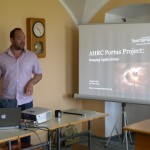17th-century English ship remains found in St. Mary’s City, Maryland, USA
Ship Remains Identified in the St. Mary’s River
Working and pleasure boats have plied Maryland waters for centuries. No one knows how many wrecked or abandoned ships lay hidden In Maryland’s rivers and bays. One suspected underwater site that was first mapped in 1994 gave up some of its secrets this summer. Scott Tucker, archaeologist and doctoral candidate from University of Southampton in the United Kingdom, has been exploring what may be the remains of a ship in the St.
Continue reading →






